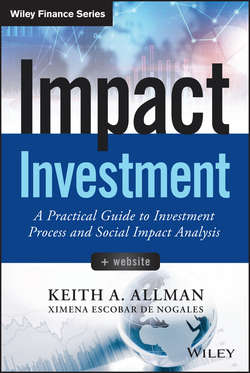Читать книгу Impact Investment - Allman Keith А. - Страница 7
На сайте Литреса книга снята с продажи.
Chapter 1
Introduction to Impact Investing
What Is an Impact Investment?
ОглавлениеAn impact investment can take many forms, but all share the idea that capital can be deployed into an entity making a good or providing a service that offers positive social impact, while also generating some level of financial return. The Global Impact Investing Network (GIIN), one of the major impact investing industry organizations, defines impact investments as “investments made into companies, organizations, and funds with the intention to generate social and environmental impact alongside a financial return.”3 Critical to this definition is the intentionality of the investor to deliver on financial and social returns.
The form of investment can be as straightforward as investing money for shares of equity in a company or much more complicated, such as a convertible debt structure. Core investment funds may not even have to be exchanged, as in the case of credit guarantees. The unifying thought, though, is that an investor is committing capital to a commercial business, which aims to compensate the investor for his or her investment.
Geographically, impact investments can be made anywhere. Impact investments exist in emerging or developed markets, as long as the focus remains on coupling social or environmental impacts with financial returns. Although examples in developed markets are less common, programs such as investment funds that target small businesses in East London could be considered impact investments.
With all of these options, the two primary forms of investment into social enterprises are debt and equity, mostly in emerging markets. Much of the recent enthusiasm over impact investing has been targeted at investments in social enterprises. These are companies that are for-profit, but have created a good or service that provides significant social impact. Given their early stage and venture nature, the more typical form of investment in these companies is equity. Debt does come into play in impact investing, particularly with new debt funds creating specialized products, but equity is still the predominant force in early stage social enterprises.
Debt is also relevant for impact investing when we consider microfinance, which is a specialized sector of impact investing. Microfinance involves lending small amounts of money to individuals or groups of individuals, who then use that money to fund their own businesses. The borrowers agree to pay back the loan, plus interest. Microfinance institutions, which provide the direct borrower funding and collection services, have grown over the years and are recipients of debt and equity investments themselves. All of these would be considered a type of impact investment.
For the most part, what has been described so far are investments. An investor provides capital and expects return. The key differentiator for impact investing is the impact. We will work to define impact later in this chapter, but an impact investment differs from a traditional investment in that the core business product or service provides a positive social impact. A healthcare company that provides high-quality, affordable tiered services for low- to middle-income patients, for profit, would most likely qualify as an impact investment. A healthcare company that builds clinics for wealthy clients and donates 1 percent of profits to charity would most likely not be considered an impact investment. The social impact has to be engrained in the business operations, product, or service.
A specific feature of impact investing is the investor's engagement to measure and report on social and environmental performance and impact. Impact investments should aim to be evidence-based investments. This means the industry needs to build data on the type of interventions that have a positive development impact. Impact investors need to examine and share learnings on the combination of products and services, the type of designs, the pricing and distribution models, and the accompanying services that will result in positive societal impact on the targeted population. Obvious as it is, it may be worth reiterating: Without evidence, we will not make evidence-based investments. In this book, we go through the challenges of defining adequate impact models, identifying appropriate indicators to track, and monitoring and analyzing output, outcome, and impact indicators.
3
The Global Impact Investing Network, “What is Impact Investing?” www.thegiin.org/cgi-bin/iowa/resources/about/index.html#1.
